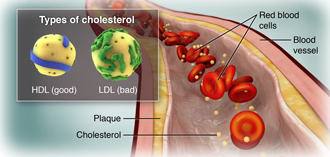Cholesterol in the Blood
Featured Expert:
Facts about cholesterol
Cholesterol is a fat-like, waxy substance that helps your body make cell membranes, many hormones, and vitamin D. The cholesterol in your blood comes from two sources: the foods you eat and your liver. Your liver makes all the cholesterol your body needs.
Cholesterol and other fats are carried in your bloodstream as spherical particles called lipoproteins. The two most commonly known lipoproteins are low-density lipoproteins (LDL) and high-density lipoproteins (HDL).
| What is LDL (low-density lipoprotein) cholesterol? | What is HDL (high-density lipoprotein) cholesterol? |
|---|---|
|
LDL (“bad") cholesterol can contribute to the formation of plaque buildup in the arteries (atherosclerosis). This is linked to higher risk for heart attack and stroke. You want your LDL below 70 milligrams per deciliter (mg/dl). Here’s what helps:
|
HDL stands for high density lipoprotein. HDL levels should be around 50 mg/dL. Some people can raise HDL by::
|
Checking your blood cholesterol level
A cholesterol screening is an overall look at the fats in your blood. Screenings help identify your risk for heart disease. It is important to have what is called a full lipid profile to show the actual levels of each type of fat in your blood: LDL, HDL, triglycerides, and others. Talk with your healthcare provider about when to have this test.
What is a healthy blood cholesterol level?
For people who have plaque in their arteries or who have other factors that put them at risk for cardiovascular disease, doctors recommend an ideal LDL level well below 70 mg/dl. For those without risk factors who have an LDL level at or above 190 mg/dl, the recommendation is to get this level down to below 100 mg/dl. People age 40 to 75 who are living with diabetes and whose LDL is at 70 or above may need medication.
What treatments are available for high cholesterol?
Treatment may include:
-
Addressing risk factors. Some risk factors that can be changed include lack of exercise and poor eating habits.
-
Cholesterol-lowering medicines. Medicines are used to lower fats in the blood, particularly LDL cholesterol. Statins are a group of medicines that can do this. The two most effective types are atorvastatin and rosuvastatin. Other medicines that lower cholesterol levels are ezetimibe and PCSK9 inhibitors.
Cholesterol Statistics
According to the American Heart Association (AHA), about 95 million American adults have total blood cholesterol levels of 200mg/dl and higher.
Of those, about 28.5 million American adults have a level of 240 or above.
High cholesterol levels early in life may play a role in developing atherosclerosis as an adult.
What are triglycerides?
Triglycerides are another class of fat found in the bloodstream. The bulk of your body's fat tissue is in the form of triglycerides.
Triglyceride levels and heart disease
The link between triglycerides and heart disease is being studied. But many people with high triglycerides also have other risk factors, like high LDL levels or low HDL levels.
What causes elevated triglyceride levels?
High triglyceride levels may be caused by health conditions like diabetes, hypothyroidism, kidney disease, or liver disease. Dietary causes of high triglyceride levels may include drinking a lot of alcohol, and eating foods containing cholesterol, saturated fat, and trans fat.







